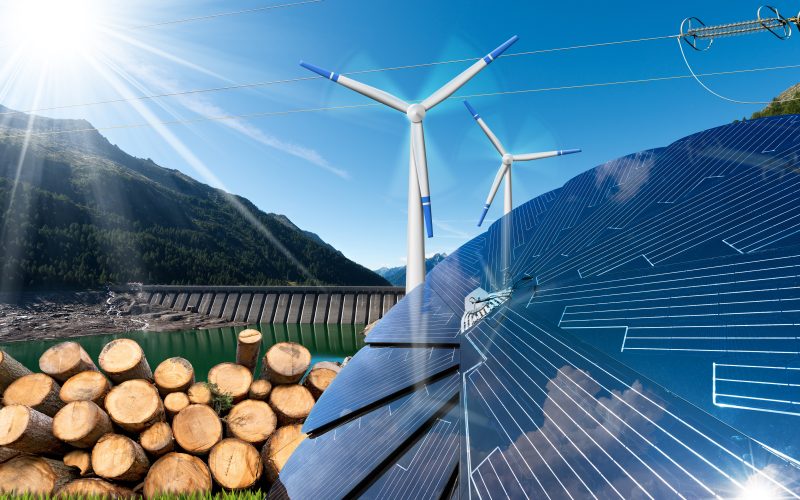Next-Generation Photovoltaic Cells

Next-Generation Photovoltaic Cells enhance Renewable Energy efficiency. The advancements in photovoltaic technology have led to significant improvements in the efficiency of solar cells. Traditional silicon-based solar cells are now being supplemented and, in some cases, replaced by next-generation materials such as perovskites and organic photovoltaics. These new materials offer higher energy conversion efficiencies and can be produced at lower costs, making solar energy more accessible and affordable. The improved efficiency of these cells means that more electricity can be generated from the same amount of sunlight, thereby enhancing the overall efficiency of renewable energy systems.
Advancements in Photovoltaic Cells drive Renewable Energy adoption. As the efficiency and cost-effectiveness of photovoltaic cells improve, the adoption of solar energy systems is accelerating. Innovations such as bifacial solar panels, which can capture sunlight from both sides, and the development of flexible and lightweight solar panels, are making it easier to integrate solar technology into a variety of applications. These advancements are not only driving the adoption of renewable energy but are also expanding the potential uses of solar power, from residential rooftops to large-scale solar farms and even portable solar devices.
Offshore Wind Energy Projects
Offshore wind enhances Renewable Energy infrastructure. The development of offshore wind energy projects has significantly bolstered the renewable energy infrastructure. Offshore wind farms leverage the stronger and more consistent wind speeds found over the ocean, allowing for the generation of substantial amounts of electricity. These projects are often situated far from shore, reducing the visual and noise impact on coastal communities while providing a reliable source of renewable energy. The infrastructure required for offshore wind farms, including advanced turbines and subsea cables, represents a significant investment in renewable energy technology and capabilities.
Boosts Renewable Energy capacity with offshore wind projects. Offshore wind projects have the potential to greatly increase the capacity of renewable energy generation. By harnessing the power of ocean winds, these projects can produce large amounts of electricity that can be fed into the grid, reducing reliance on fossil fuels and lowering carbon emissions. The scalability of offshore wind farms means that they can be expanded to meet growing energy demands, making them a critical component of the renewable energy landscape. As technology advances, the efficiency and output of offshore wind turbines continue to improve, further boosting the capacity of renewable energy systems.
Small-Scale Hydropower Innovations

Small-scale hydropower enhances renewable energy accessibility. Innovations in small-scale hydropower technology have made it possible to harness the energy of flowing water in a variety of settings, from rural communities to urban environments. These systems are often more affordable and easier to install than large-scale hydropower projects, making renewable energy more accessible to a wider range of users. Small-scale hydropower can be used to generate electricity for individual homes, communities, or small industries, providing a reliable and sustainable source of power.
Innovations in small-scale hydropower drive renewable energy advancements. Recent advancements in small-scale hydropower technology, such as the development of micro-hydro turbines and improved energy storage systems, are driving the growth of renewable energy. These innovations allow for more efficient and effective use of water resources, maximizing the energy output from small streams and rivers. By making hydropower more accessible and efficient, these advancements are contributing to the overall expansion and diversification of renewable energy sources.
Enhanced Geothermal Systems
Enhanced Geothermal Systems drive Renewable Energy advancements. Enhanced Geothermal Systems (EGS) represent a significant advancement in the field of renewable energy. By artificially stimulating geothermal reservoirs, EGS can generate electricity from geothermal resources that were previously inaccessible. This technology involves injecting water into hot rock formations deep underground, creating fractures that allow the water to circulate and absorb heat. The heated water is then brought to the surface to generate electricity. EGS has the potential to provide a consistent and reliable source of renewable energy, regardless of weather conditions or time of day.
Renewable Energy growth fueled by Enhanced Geothermal Systems. EGS technology can be implemented in a variety of geological settings, expanding the potential for geothermal energy production. By tapping into previously untapped geothermal resources, EGS is increasing the overall capacity of renewable energy systems. This growth is supported by ongoing research and development efforts aimed at improving the efficiency and cost-effectiveness of EGS technology, making it a viable and attractive option for renewable energy generation.
Sustainable Biomass Production Techniques
Innovative methods for sustainable biomass in Renewable Energy. Sustainable biomass production is critical for the continued growth of renewable energy. Innovative methods for producing biomass, such as advanced agricultural practices and the use of waste materials, are helping to ensure that biomass can be produced in an environmentally friendly and sustainable manner. These methods include the cultivation of fast-growing energy crops, the utilization of agricultural and forestry residues, and the development of algae-based biofuels. By optimizing biomass production, these innovative techniques are contributing to the overall sustainability of renewable energy systems.
Optimizing biomass yield for Renewable Energy advancements. Optimizing the yield of biomass resources is essential for advancing renewable energy. Techniques such as genetic engineering, improved crop management practices, and the development of high-yielding plant varieties are being used to increase the productivity of biomass crops. Additionally, advancements in biomass processing and conversion technologies are enhancing the efficiency of converting biomass into usable energy. By maximizing the yield and efficiency of biomass production, these advancements are driving the growth and development of renewable energy systems.
Wave and Tidal Energy Technologies

Wave energy: A promising Renewable Energy source. Wave energy technology harnesses the power of ocean waves to generate electricity, offering a promising source of solar energy. Devices such as point absorbers, oscillating water columns, and attenuators are being developed and deployed to capture the energy of waves and convert it into electrical power. Wave energy has the potential to provide a consistent and reliable source of solar energy, particularly in coastal regions with strong wave activity. Ongoing research and development efforts are focused on improving the efficiency and durability of wave energy devices, making this technology an increasingly viable option for renewable energy generation.
The development of advanced materials and engineering techniques is improving the performance and longevity of tidal energy systems, making them a more attractive option for solar energy generation. By harnessing the natural movement of tides, tidal energy technology is contributing to the overall sustainability and resilience of solar energy systems.
Smart Grid and Distributed Energy Resources
Smart Grid enhances Renewable Energy integration and efficiency. The development of smart grid technology is playing a crucial role in enhancing the integration and efficiency of solar energy systems. Smart grids use advanced sensors, communication networks, and data analytics to monitor and manage the flow of electricity in real-time. This allows for more efficient distribution of power, better integration of solar energy sources, and improved grid stability. By enabling more effective management of energy resources, smart grid technology is helping to maximize the use of renewable energy and reduce reliance on fossil fuels.
Distributed Energy Resources boost Renewable Energy adoption and resilience. Distributed Energy Resources (DERs), such as rooftop solar panels, small wind turbines, and energy storage systems, are boosting the adoption and resilience of solar energy. DERs allow for the generation and storage of electricity at or near the point of use, reducing the need for centralized power plants and long-distance transmission lines. This decentralized approach to energy generation enhances the resilience of the power grid, making it less vulnerable to disruptions. By providing a more flexible and adaptable energy system, DERs are driving the growth and adoption of solar energy technologies.
International Collaboration on Renewable Energy Initiatives
International collaboration accelerates renewable energy advancements globally. The global nature ofsolar energy challenges and opportunities has led to increased international collaboration on solar energy initiatives. Countries around the world are working together to share knowledge, technology, and resources to accelerate the development and deployment of solar energy systems. Collaborative efforts include joint research projects, technology transfer agreements, and international funding mechanisms. By pooling resources and expertise, international collaboration is helping to overcome barriers to solar energy adoption and drive global progress toward a sustainable energy future.
Joint ventures enhance solar energy technology and resource sharing. Joint ventures between countries, companies, and research institutions are enhancing the development and deployment of solar energy technologies. These partnerships facilitate the sharing of resources, such as funding, technology, and expertise, and enable the scaling up of solar energy projects. Joint ventures also promote the exchange of best practices and innovative solutions, helping to drive continuous improvement in solar energy systems. By working together, stakeholders can achieve greater impact and accelerate the transition to a solar energy future










